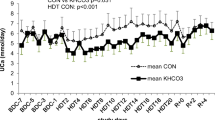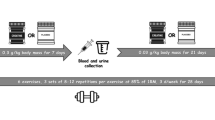Abstract
Calcium (Ca) supplements may be used to normalize Ca-balance changes but little is known about the effect of Ca supplements on Ca balance during hypokinesia (decreased kilometers per day). The aim of this study was to evaluate the effect of daily intakes of Ca supplements on Ca balance during hypokinesia (HK).
Studies were done during 30 d of a pre-HK period and during 364 d of a HK period. Forty male athletes aged 23–26 yr were chosen as subjects. They were divided equally into four groups: unsupplemented ambulatory control subjects (UACS), unsupplemented hypokinetic subjects (UHKS), supplemented hypokinetic subjects (SHKS), and supplemented ambulatory control subjects (SACS). The SHKS and UHKS groups were kept under an average running distance of 0.7 km/d. In the SHKS and SACS groups supplemented with 35.0 mg Ca lactate/kg body weight.
Fecal Ca loss, urinary excretion of Ca and phosphate (P), serum concentrations of ionized calcium (CaI) total Ca, P, and Ca balance, intact parathyroid hormone (iPTH) and 1,25 dihydroxyvitamin D (1,25(OH)2D), anthropometric characteristics and peak oxygen uptake were measured. Fecal Ca excretion, urinary Ca and P excretion, serum CaI, total Ca, and P concentration, and negative Ca balanced increased significantly (p ≤ 0.01) in the SHKS and UHKS groups when compared with the SACS and UACS groups. Serum, urinary, and fecal Ca changes were much greater and appeared much faster in the SHKS group than in the UHKS group. Serum iPTH and 1,25 (OH)2 D, body weight, and peak oxygen uptake decreased significantly (p ≤ 0.01) in the SHKS and UHKS groups when compared with the SACS and UACS groups. In contrast, the corresponding parameters remained stable in the SACS and UACS groups when compared with the baseline control values.
It was concluded that during prolonged HK, urinary and fecal Ca excretion and serum Ca concentration increased significantly despite the presence of a negative Ca balance; thus, Ca supplements cannot be used to normalize negative Ca balance during prolonged HK.
Similar content being viewed by others
References
V. I. Fedorov, Intensity of autolysis of animal tissues during hypodynamia, Kosmicheskya Biol. 5, 82–84 (1971).
I. V. Fedorov, A. V. Chernyy, and A. I. Fedorov, Synthesis and catabolism of tissue proteins in animals during hypodynamia and resumption of muscular activity, Kosmicheskaya Biol. 11, 1128–1133 (1977).
I. V. Fedorov, Biochemical basis of pathogenesis of hypokinesia, Kosmicheskya Biol. 14, 3–10 (1980).
Y. G. Zorbas, G. E. Verentsov, and Y. F. Federenko, Renal excretion of end products of protein metabolism in urine of endurance trained subjects during restriction of muscular activity, Panminerva Med. 37, 109–114 (1995).
A. V. Volozhin, Pathogenesis of disturbances of calcium metabolism in mineralized tissues during prolonged hypokinesia, Ph.D. thesis, “Interkosmos” Council, Academy of Sciences USSR and Directorate of Kosmic Biology and Medicine, Ministry of Health USSR, Moscow (1978).
V. P. Krotov, Kinetics and regulation of fluid and electrolytes metabolism in animals and human beings during prolonged hypokinesia, Ph.D. thesis, “Interkosmos” Council, Academy of Sciences USSR and Directorate of Kosmic Biology and Medicine, Ministry of Health USSR, Moscow (1978).
Y. G. Zorbas, Y. F. Federenko, and K. A. Naexu, Renal excretion of fluid and electrolytes during potassium and calcium loading during hypokinesia and physical exercise, Model. Simul. Control 41, 19–36 (1993).
Y. G. Zorbas, M. N. Ichinose, and M. B. Sakagamis, Fluid electrolyte changes in physically health subjects during prolonged restriction of motor activity and daily hyperhydration, Mater. Med. Polona 25, 97–107 (1993).
Y. G. Zorbas, Y. F. Federenko, and K. A. Naexu, Calcium loading and renal function in trained subjects during restriction of muscular activity and chronic hyperhydration, Biol. Trace Element Res. 41, 137–156 (1994).
J. H. Lohman, A. F. Roche, and R. Martorell (eds.), Anthropometric Standardization Reference Manual, Human Kinetics, Champaign, IL (1988).
J. Brozek, F. Grande, J. T. Anderson, and A. Keys, Densitometric analysis of body composition, Ann. NY Acad. Sci. 110, 113–140 (1963).
T. M. Lobova, Blood and tissue lipids in hypokinetic rats, Kosmicheskaya Biol. 7, 32–35 (1973).
Yu. P. Ryl’nikov, Hypokinetic effect on the lipid composition of blood and tissues of rabbits of different age, Kosmicheskaya Biol. 8, 8–13 (1974).
Y. G. Zorbas and V. M. Petrovskiy, Carbohydrate and lipid metabolism of the heart and liver in rabbits under hypokinetic stress, in Pathogenesis of Stress-Induced Heart Diseases, R. E. Beamish, V. Panagia, and N. S. Dhalla, eds., Martinus Nijhoff Publishing, Boston, pp. 397–404 (1984).
V. A. Tishler, V. M. Zatsiorskiy, and V. N. Seluyanov, Study of mass-inertia characteristics of human body segments during six month hypokinesia by gamma scanning method, Kosmicheskaya Biol. 15, 36–42 (1981).
Y. G. Zorbas, V. R. Bobylev, and A. N. Naexu, Physical exercise in preserving men’s body mass under hypokinesia, Int. J. Rehab. Res. 12, 326–330 (1989).
Y. G. Zorbas, V. R. Bobylev, A. N. Marketi, and Y. F. Federenko, Body mass changes in endurance trained volunteers during prolonged restriction of muscular activity and chronic hyperhydration, Sports Med. Training Rehab. 4, 167–176 (193).
Ye. V. Gusevas and R. Yu. Tashpulatov, Effect of flights of differing duration on protein composition of cosmonauts blood, Kosmicheskaya Biol. 14, 13–17 (1980).
Y. G. Zorbas, Y. Y. Yaroshenko, O. L. Georgeascu, and M. N. Tanaka, Haemoglobin mass after hypokinesia and physical exercise with chronic hyperhydration, Model. Simul. Control 21, 43–56 (1990).
Y. G. Zorbas, A. L. Ivanov, and Y. K. Imura, Changes in total body potassium, haemoglobin and bromine space after hypokinesia and physical exercise, Mater. Med. Polona 22, 300–303 (1990).
Author information
Authors and Affiliations
Rights and permissions
About this article
Cite this article
Zorbas, Y.G., Petrov, K.L., Kakurin, V.J. et al. Calcium supplementation effect on calcium balance in endurance-trained athletes during prolonged hypokinesia and ambulatory conditions. Biol Trace Elem Res 73, 231–250 (2000). https://doi.org/10.1385/BTER:73:3:231
Received:
Accepted:
Issue Date:
DOI: https://doi.org/10.1385/BTER:73:3:231




